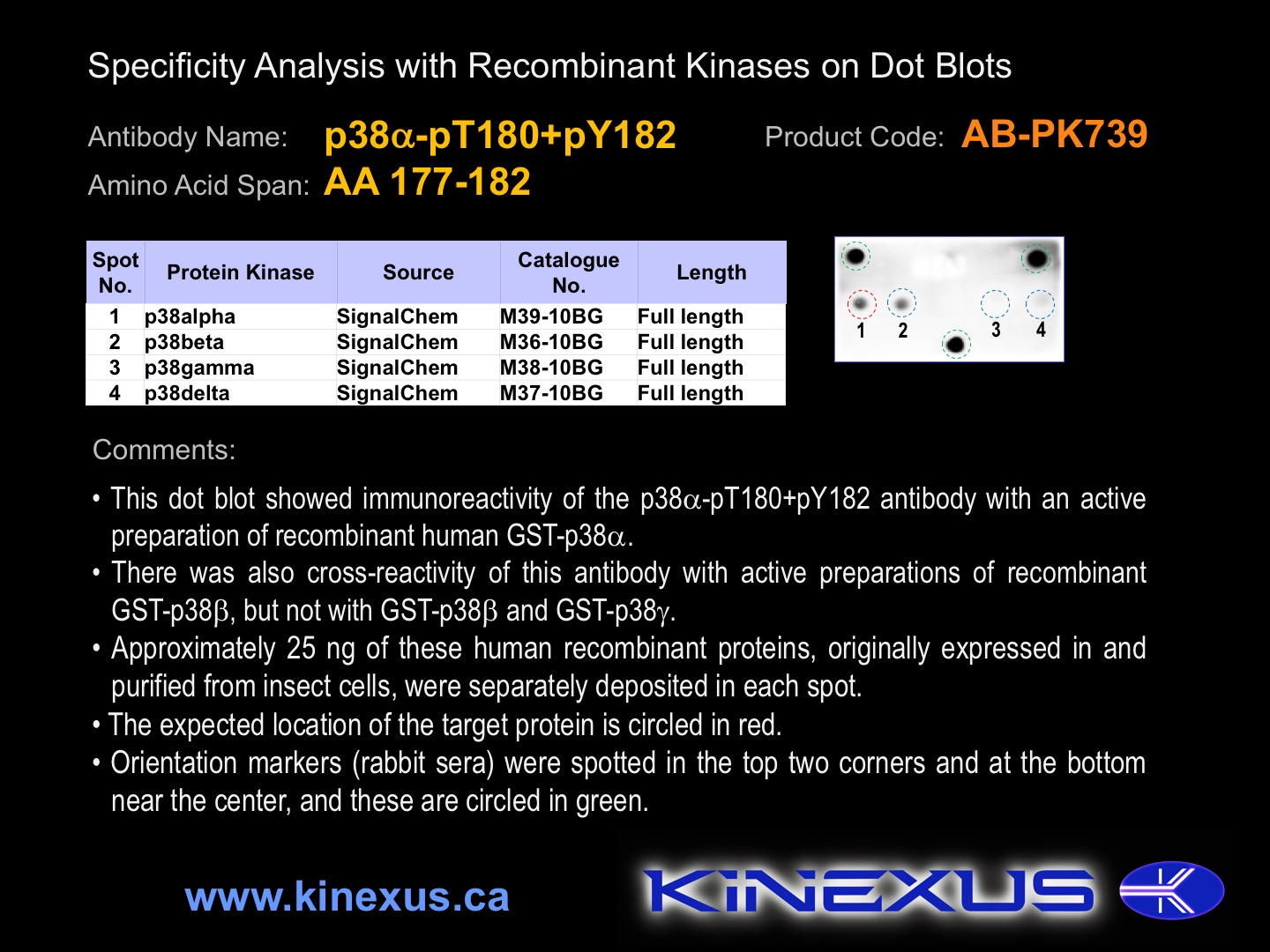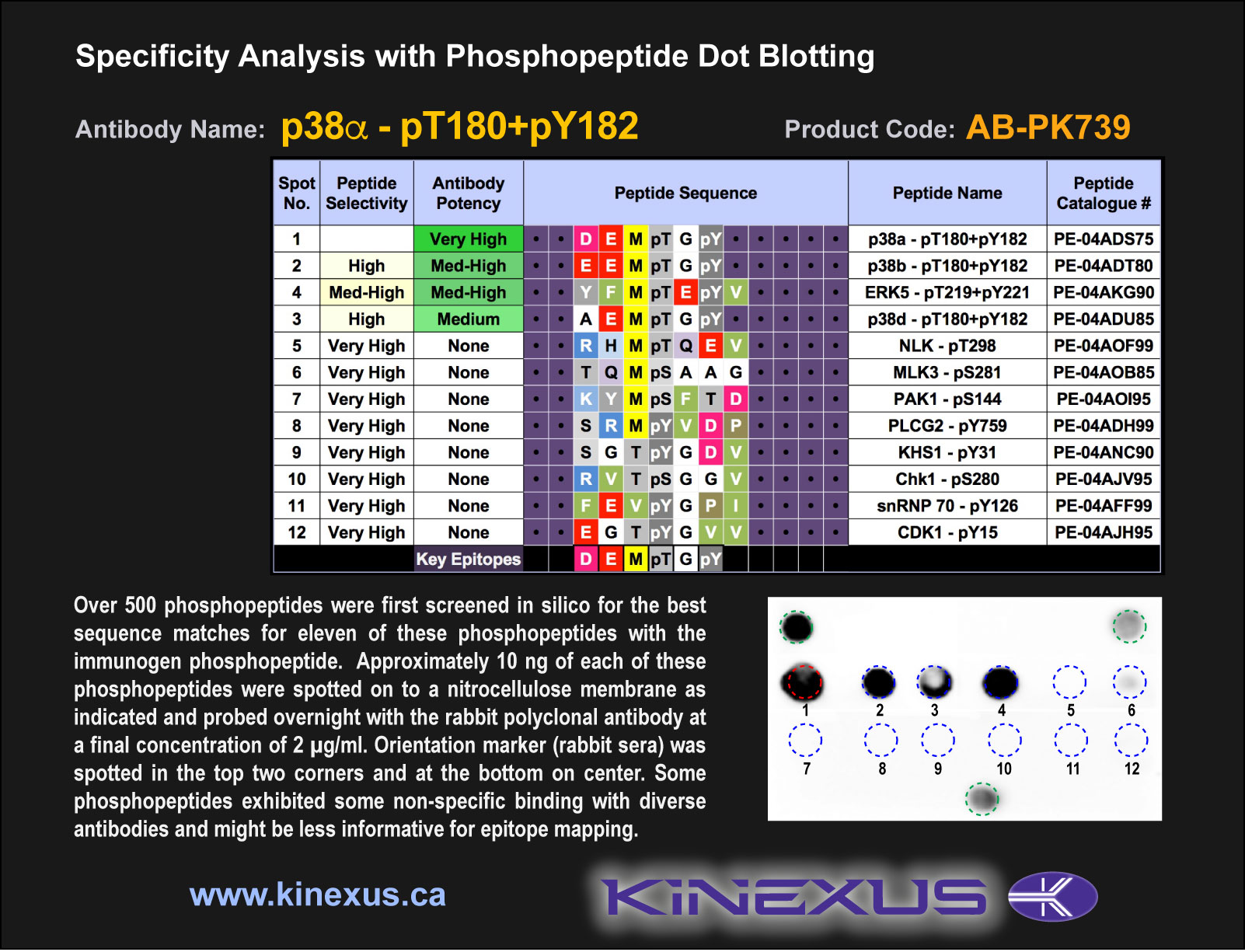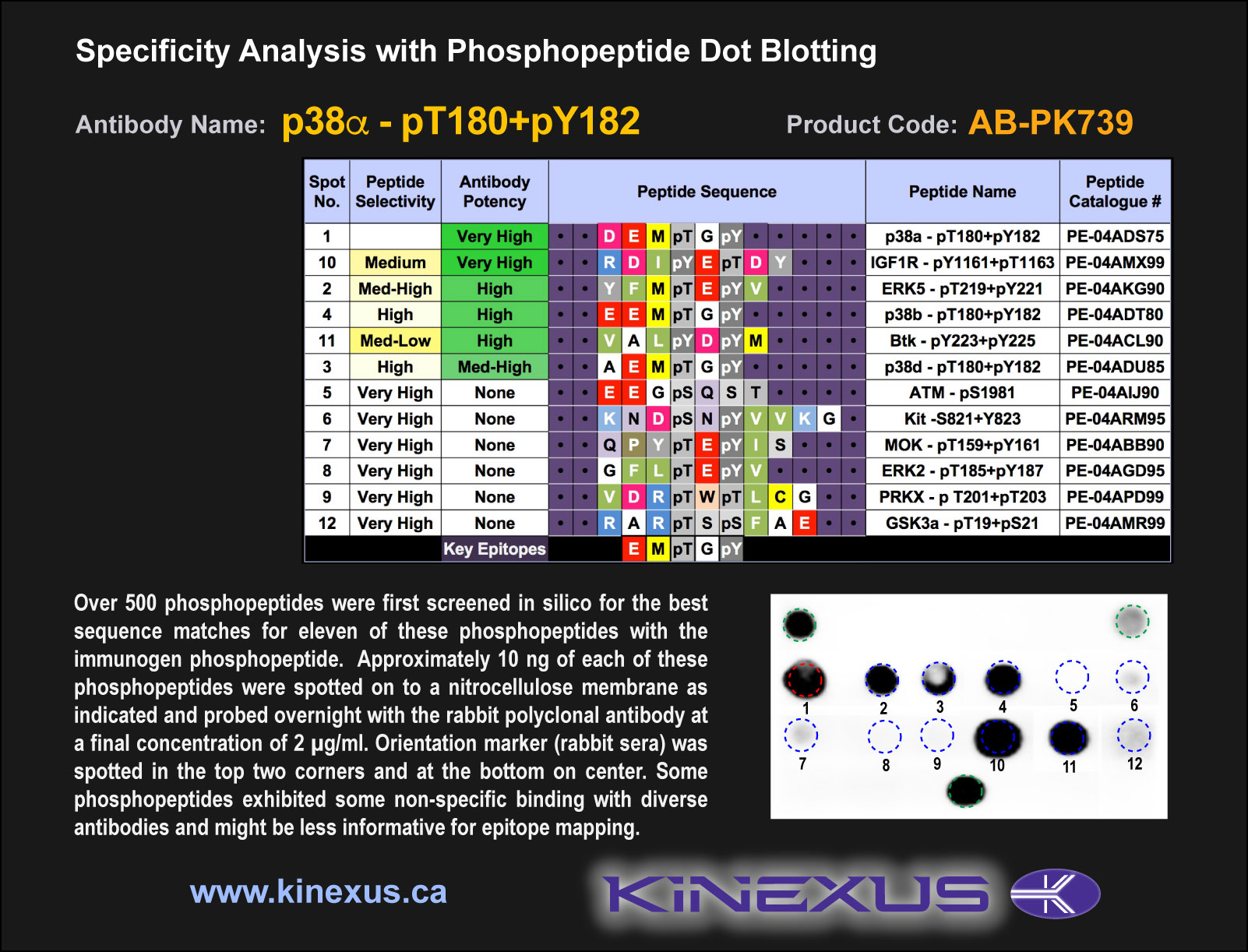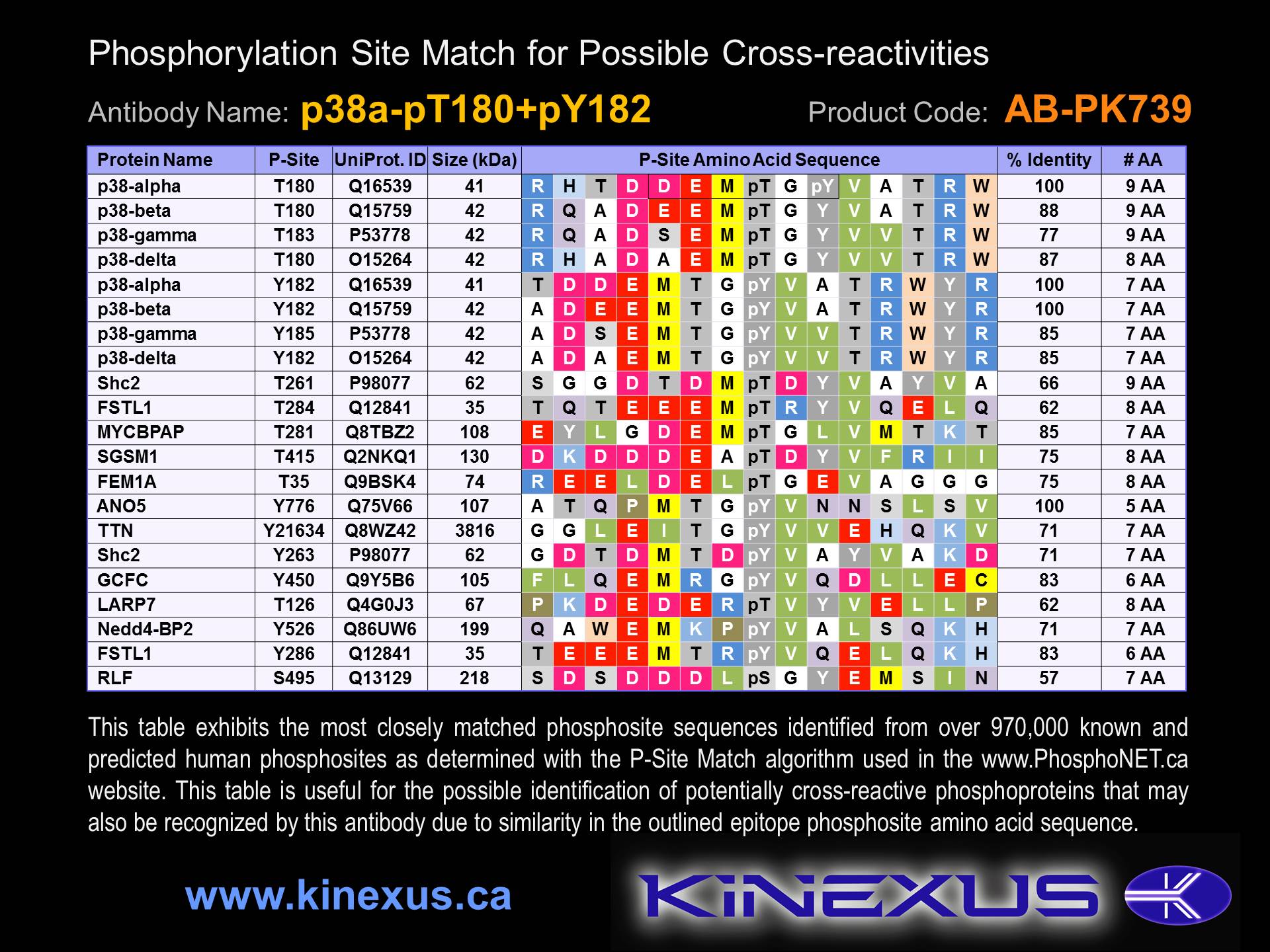Product Name: p38a-pT180+pY182
Product Number: AB-PK739
| Size: | 25 µg | Price: | 89.00 | |
| $US |
Target Full Name: Mitogen-activated protein-serine kinase p38 alpha; Mitogen-activated protein kinase 14
Target Alias: CRK1; CSAID binding protein; CSBP; CSBP1; CSBP2; CSPB1; Cytokine suppressive anti-inflammatory drug binding protein; Kinase p38-alpha; MAPK14; PRKM15; p38a MAPK; SAPK2A; Mxi2; CCDS4815.1; ENSG00000112062
Product Type Specific: Protein kinase phosphosite-specific antibody
Antibody Code: PK739
Antibody Target Type: Phosphosite-specific
Antibody Phosphosite: T180+Y182
Protein UniProt: Q16539
Protein SigNET: Q16539
Antibody Type: Polyclonal
Target Alias: CRK1; CSAID binding protein; CSBP; CSBP1; CSBP2; CSPB1; Cytokine suppressive anti-inflammatory drug binding protein; Kinase p38-alpha; MAPK14; PRKM15; p38a MAPK; SAPK2A; Mxi2; CCDS4815.1; ENSG00000112062
Product Type Specific: Protein kinase phosphosite-specific antibody
Antibody Code: PK739
Antibody Target Type: Phosphosite-specific
Antibody Phosphosite: T180+Y182
Protein UniProt: Q16539
Protein SigNET: Q16539
Antibody Type: Polyclonal
Antibody Host Species: Rabbit
Antibody Immunogen Source: Human p38a MAPK (MAPK14) sequence peptide Cat. No.: PE-04ADS75
Antibody Immunogen Sequence: DEM(pT)G(pY)(bA)C
Antibody Immunogen Description: Corresponds to amino acid residues D177 to Y182; In protein kinase catalytic domain activation T-loop between subdomains VII and VIII.
Antibody Immunogen Source: Human p38a MAPK (MAPK14) sequence peptide Cat. No.: PE-04ADS75
Antibody Immunogen Sequence: DEM(pT)G(pY)(bA)C
Antibody Immunogen Description: Corresponds to amino acid residues D177 to Y182; In protein kinase catalytic domain activation T-loop between subdomains VII and VIII.
Production Method: The immunizing peptide was produced by solid phase synthesis on a multipep peptide synthesizer and purified by reverse-phase hplc chromatography. Purity was assessed by analytical hplc and the amino acid sequence confirmed by mass spectrometry analysis. This peptide was coupled to KLH prior to immunization into rabbits. New Zealand White rabbits were subcutaneously injected with KLH-coupled immunizing peptide every 4 weeks for 4 months. The sera from these animals was applied onto an agarose column to which the immunogen peptide was thio-linked. Antibody was eluted from the column with 0.1 M glycine, pH 2.5. Subsequently, the antibody solution was neutralized to pH 7.0 with saturated Tris.This antibody was also subject to negative purification over phosphotyrosine-agarose.
Antibody Modification: Unconjugated. Contact KInexus if you are interest in having the antibody biotinylated or coupled with fluorescent dyes.
Antibody Modification: Unconjugated. Contact KInexus if you are interest in having the antibody biotinylated or coupled with fluorescent dyes.
Antibody Concentration: 0.5 mg/ml
Storage Buffer: Phosphate buffered saline pH 7.4, 0.05% Thimerasol
Storage Conditions: For long term storage, keep frozen at -40°C or lower. Stock solution can be kept at +4°C for more than 3 months. Avoid repeated freeze-thaw cycles.
Product Use: Western blotting | Antibody microarray
Antibody Dilution Recommended: 2 µg/ml for immunoblotting
Antibody Potency: Very strong immunoreactivity with immunogen peptide on dot blots.
Antibody Species Reactivity: Human
Antibody Positive Control: The observed molecular mass of the processed target protein on SDS-PAGE gels is reported to be around 38-43 kDa.
Storage Buffer: Phosphate buffered saline pH 7.4, 0.05% Thimerasol
Storage Conditions: For long term storage, keep frozen at -40°C or lower. Stock solution can be kept at +4°C for more than 3 months. Avoid repeated freeze-thaw cycles.
Product Use: Western blotting | Antibody microarray
Antibody Dilution Recommended: 2 µg/ml for immunoblotting
Antibody Potency: Very strong immunoreactivity with immunogen peptide on dot blots.
Antibody Species Reactivity: Human
Antibody Positive Control: The observed molecular mass of the processed target protein on SDS-PAGE gels is reported to be around 38-43 kDa.
Antibody Specificity: Medium-High
Antibody Cross Reactivity: No immunoreactivity with recombinant human p38a, p38b, p38d or p38g. High background with antibody in HepG2 cells. In Jurkat cells, phenylarsine oxide (PAO) increases detection of 15 kDa protein.
Related Product 1: p38a-pT180+pY182 blocking peptide
Related Product 2: p38 pan-specific antibody (Cat. No.: AB-NK120-5)
Related Product 3: p38 alpha (MAP Kinase) pan-specific antibody (Cat. No.: AB-NK120-4)
Related Product 4: p38a-2 pan-specific antibody (Cat. No.: AB-NK120-8)
Related Product 5: p38a-pT180+Y182 phosphosite-specific antibody (Cat. No.: AB-PK740)
Antibody Cross Reactivity: No immunoreactivity with recombinant human p38a, p38b, p38d or p38g. High background with antibody in HepG2 cells. In Jurkat cells, phenylarsine oxide (PAO) increases detection of 15 kDa protein.
Related Product 1: p38a-pT180+pY182 blocking peptide
Related Product 2: p38 pan-specific antibody (Cat. No.: AB-NK120-5)
Related Product 3: p38 alpha (MAP Kinase) pan-specific antibody (Cat. No.: AB-NK120-4)
Related Product 4: p38a-2 pan-specific antibody (Cat. No.: AB-NK120-8)
Related Product 5: p38a-pT180+Y182 phosphosite-specific antibody (Cat. No.: AB-PK740)
Related Product 6: p38SelectideA - p38a MAPK (MAPK14) protein kinase substrate peptide
Related Product 7: p38Subtide - p38a MAPK (MAPK14) protein kinase substrate peptide
Related Product 7: p38Subtide - p38a MAPK (MAPK14) protein kinase substrate peptide
Scientific Background: p38a (MAPK14) is a protein-serine/threonine kinase of the CMGC group and MAPK family, and a member of the p38 stress-activated MAP kinases. It is activated by pro-inflammatory cytokines, environmental stress and LPS. Phosphorylation at T180 and Y182 increases its phosphotransferase activity. These phospho-sites are targeted by MKK3 (MAP2K3), MKK6 (MAP2K6), and potentially also MKK4 (MAP2K4). Phosphorylation at Y323 also increases its phosphotransferase activity. It is inhibited by dual specificity phosphatases, such as DUSP1. Phosphorylation at T123 inhibits phosphotransferase activity and interaction with MKK6 and MAPKAPK2. Its many substrates include the transcription regulators ATF2, MEF2C, and MAX; the cell cycle regulator CDC25B; and p53, which indicates that p38a plays a role in stress-related transcription and in cell cycle regulation, as well as in the genotoxic stress response. It is a key player in the maintenance of hematopoiesis homeostasis, as it balances both proliferative and growth inhibitory signals from growth factors/cytokines that regulate hematopoiesis. Alterations in this controlled balance could result in either overproduction or depletion of myelosuppressive cytokines, which could lead to the development of various types of bone marrow failures. p38a may be also involved in drug resistance development of acute myeloid leukemias.
Figure 1. Dot blotting p38a-pT180+pY182 antibody with recombinant purified proteins.
Figure 2. Epitope mapping of p38a-pT180+pY182 antibody with similar phosphopeptides on dot blots.
Figure 3. Epitope mapping of p38a-pT180+pY182 antibody with similar phosphopeptides on dot blots.
Figure 4. Identification of phosphosites related to p38a-pT180+pY182.
© Kinexus Bioinformatics Corporation 2017





